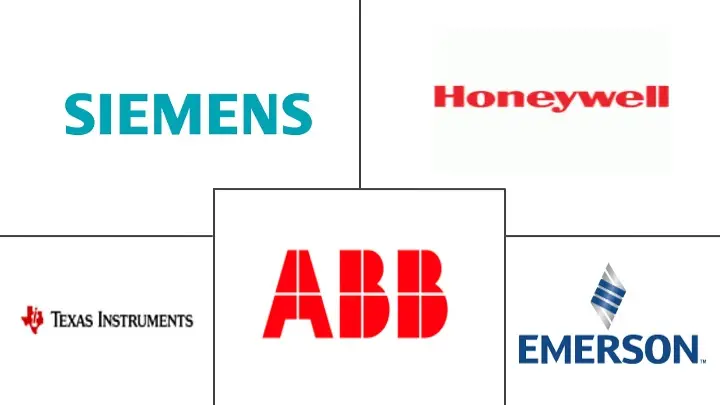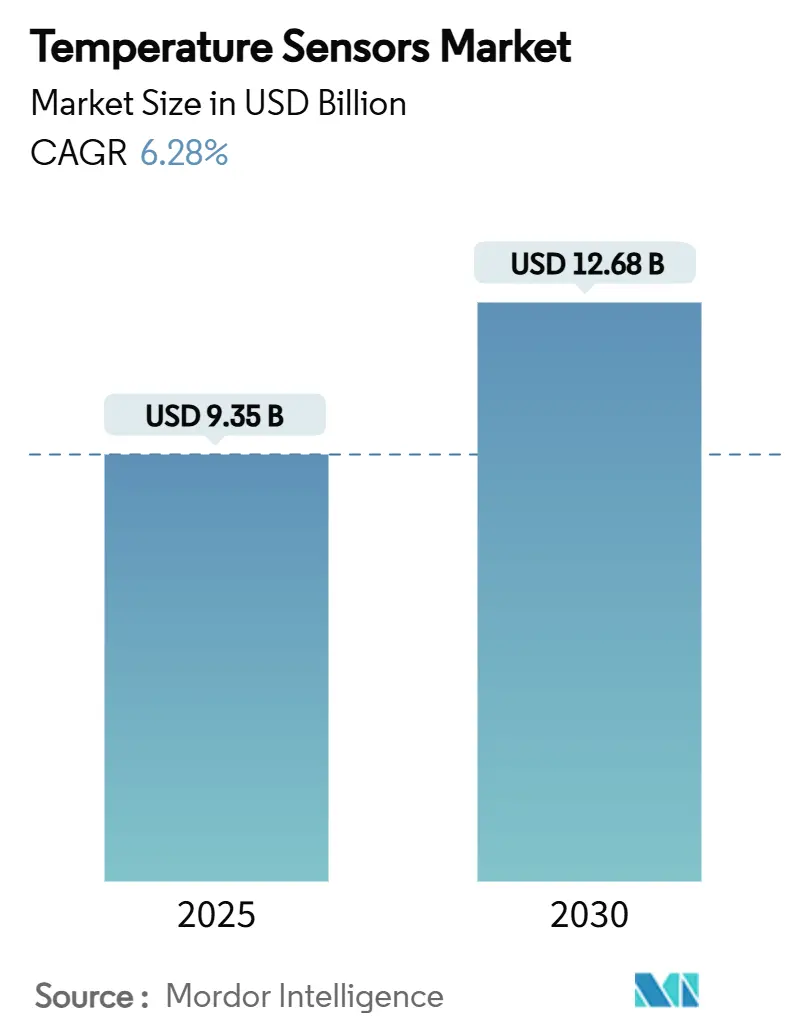
Temperature Sensors Market Analysis by Mordor Intelligence
The temperature sensor market size has reached USD 9.35 billion in 2025 and is forecast to climb to USD 12.68 billion by 2030, registering a 6.28% CAGR. Demand is rising as industrial facilities digitize, electric vehicles proliferate, and life-science supply chains enforce real-time thermal traceability. Regulatory cold-chain mandates for biologics, hyperscale data-center buildouts that favor fiber-optic distributed sensing, and widespread IIoT adoption across European process plants jointly elevate sensor volumes. Growth is further strengthened by GaN/SiC power-electronics adoption, which raises precision-cooling requirements, and by 5G base-station deployments that need on-board thermal monitoring to protect uptime. On the supply side, vertically integrated incumbents counter price pressure from low-cost Asian suppliers by focusing on high-accuracy products and wireless retrofit solutions that reduce total installed cost.
Key Report Takeaways
- By geography, Asia-Pacific held 44.9% of the temperature sensor market share in 2024 and is expanding at 7.2% CAGR through 2030.
- By connectivity, wired sensors led with 84.7% revenue share in 2024; wireless is the fastest-growing segment at 11.8% CAGR through 2030.
- By Output, Analog devices retained 71.2 % revenue in 2024 because 4–20 mA loops still anchor distributed-control-system (DCS) inputs in refineries and steel mills. Digital sensors, however, are expanding 9.4 % CAGR to 2030.
- By technology, thermocouples captured 40.3% of 2024 revenue, whereas fiber-optic distributed sensing is advancing at a 10.6% CAGR to 2030.
- By end user, oil & gas retained an 18.1% share in 2024; medical & healthcare applications are progressing at 8.7% CAGR through 2030.
- Honeywell, Siemens, and Texas Instruments together accounted for a double-digit temperature sensor market share in 2024, leveraging vertical integration to protect margins.
Global Temperature Sensors Market Trends and Insights
Drivers Impact Analysis
| Driver | ( ) % Impact on CAGR Forecast | Geographic Relevance | Impact Timeline |
|---|---|---|---|
| Expansion of Smart IIoT Temperature Networks in European Process Industries | 1.20% | Europe, spill-over to North America | Medium term (2-4 years) |
| GaN/SiC Power Electronics Adoption Elevating Precision-Cooling Sensor Demand | 0.80% | Asia-Pacific core, expanding global | Long term (≥ 4 years) |
| Mandatory Cold-Chain Traceability for Biologics & mRNA Vaccines | 1.50% | North America & EU, emerging APAC | Short term (≤ 2 years) |
| 5G Base-Station Roll-outs Requiring On-Board Thermal Monitoring | 0.70% | Asia-Pacific, selective global | Medium term (2-4 years) |
| Electrified-Mobility Thermal-Management Modules Adoption | 1.10% | Europe & North America, expanding APAC | Medium term (2-4 years) |
| Hyperscale Data-Center Build-out Driving Fiber-Optic Distributed Sensing | 0.90% | Global | Long term (≥ 4 years) |
| Source: Mordor Intelligence | |||
Expansion of Smart IIoT Temperature Networks in European Process Industries
European manufacturers are integrating wireless temperature nodes into existing control architectures to meet Industry 5.0 goals for energy efficiency and worker safety. [1]Siemens AG, “Temperature Sensors,” siemens.com Maintenance-free sensor designs lower lifecycle cost and simplify retrofit deployment, which is attractive in chemical-fiber plants and HVAC upgrades. AI-enabled control loops use the richer data stream to stabilize air-pressure and thermal conditions, improving product yield and reducing downtime.[2]Jiann-Shing Shieh, “Development of a Human-Centric Autonomous HVAC Control System,” MDPI, mdpi.com Return-on-investment studies in small US factories show operating savings that outweigh initial IIoT hardware spend, validating capital budgets for similar. As a result, wireless nodes gain momentum even in reliability-critical applications, accelerating the temperature sensor market toward connected architectures.
GaN/SiC Power Electronics Adoption Elevating Precision-Cooling Sensor Demand
Gallium-nitride and silicon-carbide devices operate at higher power densities, creating localized heat zones that require sub-degree monitoring accuracy. Semiconductor suppliers forecast GaN reaching commercial tipping points in fast chargers, AI servers, and electric-vehicle converters. [3]Infineon Technologies AG, “GaN to Reach Adoption Tipping Points,” infineon.com Automotive OEMs specify sensors that maintain calibration under strong electromagnetic fields, while data-center operators adopt multi-point thermal maps to contain hotspot risk. Research into aluminum-nitride thin-film sensors shows reliable operation up to 900 °C, extending sensor use into extreme power-electronics environments . Suppliers that deliver precision and EMI immunity at competitive cost are well-positioned to gain share in the temperature sensor market.
Mandatory Cold-Chain Traceability for Biologics & mRNA Vaccines
The US Food and Drug Administration continues to tighten oversight on temperature deviations in biologic distribution, and real-time loggers with GPS connectivity have become a regulatory expectation. Pharmaceutical firms lose an estimated USD 35 billion annually to temperature-induced spoilage, incentivizing investment in cloud-linked sensors that issue instant alerts. Adoption extends into last-mile distribution, boosting demand for low-power digital sensors able to operate across multiday shipments. Blockchain pilots that record immutable temperature histories further embed sensors into supply-chain architectures, raising the baseline unit volume for the temperature sensor market.
5G Base-Station Roll-outs Requiring On-Board Thermal Monitoring
High-bandwidth 5G radios dissipate more heat than LTE equipment, and equipment failures from overheating threaten service quality. Asian carriers install rugged sensors rated for outdoor temperature swings and electromagnetic interference, enabling predictive maintenance programs that cut field-repair costs. AI algorithms now dynamically throttle power amplifiers based on real-time readings, improving energy efficiency without sacrificing throughput. These roll-outs expand sensor content per base station, supporting above-average regional growth for the temperature sensor market.
Restraints Impact Analysis
| Restraint | ( ) % Impact on CAGR Forecast | Geographic Relevance | Impact Timeline |
|---|---|---|---|
| Downward ASP Pressure from Chinese Low-Cost Suppliers | −0.9% | Global, most severe APAC | Short term (≤ 2 years) |
| Supply Risk of High-Purity Platinum Wire for RTDs | −0.6% | Global, heavy industrial | Medium term (2-4 years) |
| Calibration-Drift Liability Claims in Pharma Manufacturing | −0.4% | North America & EU | Long term (≥ 4 years) |
| Extended automotive Tier-1 design-freeze cycles delaying adoption | −0.3% | Global; acute in Europe and North America | Medium term (2-4 years) |
| Source: Mordor Intelligence | |||
Downward ASP Pressure from Chinese Low-Cost Suppliers
State-supported economies of scale allow Chinese vendors to undercut global peers on commodity thermocouples and basic RTDs, eroding margins across the temperature sensor market. European firms are countering by releasing cost-efficient yet accurate models such as Sensirion’s STS4L, which draws micro-watts of power while holding ±0.4 °C accuracy, thereby defending share without direct price wars
Supply Risk of High-Purity Platinum Wire for RTDs
High-purity platinum, refined by only a handful of facilities worldwide, concentrates supply risk for RTD producers. YAGEO Nexensos is broadening refining capacity across Europe and Asia, yet geopolitical tensions could still disrupt flows, pushing OEMs toward silicon-based IC sensors where permissible
Segment Analysis
By Connectivity: Wireless Adoption Accelerates
Wired sensors continued to dominate with 84.7 % revenue in 2024, anchoring production-critical loops that must resist electromagnetic interference and latency risks. Wireless nodes are closing the gap, expanding at 11.8 % CAGR to 2030 as factories retrofit legacy lines and building-management firms deploy battery-powered transmitters that install without conduit work. The temperature sensor market benefits because every wireless retrofit typically adds extra redundancy channels, lifting unit volumes and service revenues. Use cases span chemical reactors, HVAC balancing and remote well-head monitoring, each demanding secure protocol stacks and multi-year battery life.
Rapid protocol maturation is reducing the reliability delta versus copper cabling and bringing average project payback below two years for multi-node deployments. Honeywell’s ISA100-compliant SmartLine transmitter illustrates how encrypted mesh architectures keep packet loss below 0.01 % while reporting sub-second updates [honeywell.com]. Operators also value firmware-over-the-air upgrades that let them roll out cyber-security patches without line shutdowns, a feature now common across the temperature sensor market. The overall temperature sensor industry therefore sees wireless not as a niche but as the long-term default for brown-field sites.

By Output: Digital Channels Gain Ground
Analog devices retained 71.2 % revenue in 2024 because 4–20 mA loops still anchor distributed-control-system (DCS) inputs in refineries and steel mills. Digital sensors, however, are expanding 9.4 % CAGR to 2030 as industrial Ethernet, I²C and 1-Wire buses proliferate in edge-to-cloud architectures. When digital nodes embed EEPROM-based calibration, installers no longer need plant-floor trim, cutting commissioning cost and shortening downtime. The temperature sensor market size for digital devices is projected to reach USD 5.1 billion by 2030, reflecting this accelerating conversion.
Texas Instruments’ ±0.08 °C TMP117 exemplifies how embedded CRC-protected registers improve traceability in pharmaceutical plants that must archive calibration data for FDA audits [ti.com]. Data-rich packets also enable asset-performance-management algorithms that predict failure before excursions occur, extending pump and motor life and lowering indemnity exposure. Vendors consequently bundle analytics dashboards as value-added subscriptions that smooth revenue cyclicality across the temperature sensor market.
By Technology: Fiber-Optic Distributed Sensing Scales
Thermocouples held 40.3 % of 2024 revenue thanks to 1,700 °C limits, simple construction and low unit cost. Fiber-optic distributed temperature sensing (DTS) is the fastest-growing line, climbing 10.6 % CAGR as hyperscale data centers and midstream pipelines require continuous temperature profiles over kilometers. Operators specify DTS because it provides thousands of virtual points along a single fiber, immune to EMI and capable of 1 m spatial resolution. The temperature sensor market size for DTS installations in data centers alone is forecast to post an 11 % annual increase through 2030.
AP Sensing’s Raman-backscatter platform captures ≥0.1 °C variations, feeding AI models that trim chiller energy use by up to 30 % [apsensing.com]. Meanwhile, aluminum-nitride thin-film research demonstrates calibration stability to 900 °C, pointing to crossover opportunities in GaN/SiC test rigs and geothermal wells [sciencedaily.com]. Incumbent thermocouple suppliers are responding with hybrid probes that embed fiber strands into Inconel sheaths, protecting legacy share while tapping the emerging distributed segment of the temperature sensor market.
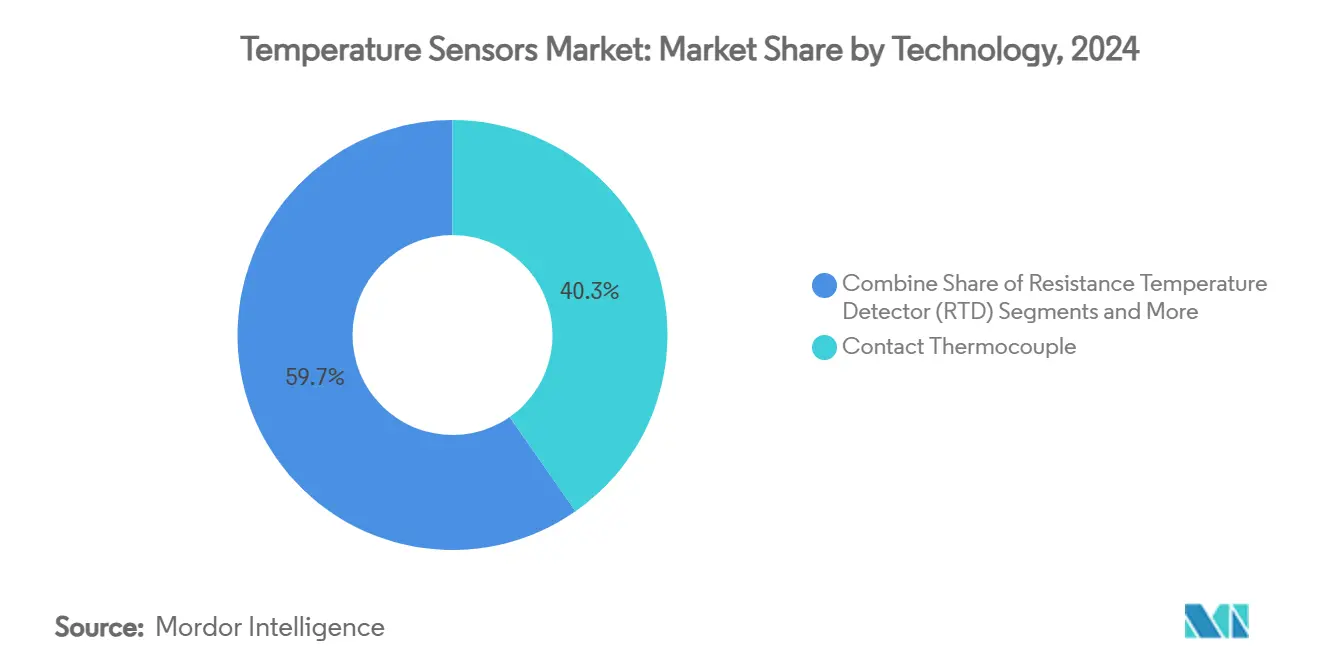
Note: Segment shares of all individual segments available upon report purchase
By End-User: Healthcare Outpaces Heavy Industry
Oil & gas led with 18.1 % contribution in 2024, driven by refinery reformer loops, LNG liquefaction trains and down-hole logging. Medical and healthcare lines are the growth engine, rising 8.7 % CAGR on the back of mRNA vaccine production and biologics cold-chain authentication. Regulatory traceability needs make high-accuracy, Bluetooth-enabled data loggers standard on every pallet, multiplying unit count per shipment. Battery EV manufacturing is another pull factor; each 80 kWh pack now integrates more than 15 cell-level probes plus coolant-loop sensors, boosting the temperature sensor market even when auto output cycles.
Data-center operators round out the demand mix by specifying fiber DTS and 1-Wire node strings for rack-level thermal mapping. A single 200 MW campus can deploy over 50,000 sensing points, dwarfing the count in conventional office HVAC. Aerospace and nuclear applications maintain premium ASP niches where redundant RTDs and ceramic thermistors are mandatory for flight safety and radiation hardness. Collectively these diverse adopters keep the temperature sensor market insulated from single-sector downturns.
Geography Analysis
Asia-Pacific generated 44.9 % of 2024 revenue and is advancing at a 7.2 % CAGR, supported by China’s 5G macro-cell rollout and India’s build-out of GMP-compliant vaccine plants. Government subsidies for EV battery lines amplify sensor density per vehicle, while domestic semiconductor fabs adopt clean-room loops that demand ±0.2 °C RTDs. Japan and South Korea add precision-manufacturing pull, especially for SiC wafer furnaces requiring 1,400 °C sensors.
North America follows with pharmaceutical cold-chain compliance and hyperscale cloud campuses that often deploy >150 km of fiber DTS per site. The FDA’s 2025 waiver on certain clinical thermometers accelerates device qualification cycles, while DOE-funded efficiency targets push data-center operators to sub-1 °C inlet-air control. Automotive Tier-1 design cycles are longer, yet every new EV platform still expands thermal nodes, tying the temperature sensor market to Detroit’s electrification timetable.
Europe prioritizes Industry 5.0 retrofits, leveraging EU-level grants for smart-factory upgrades that merge wireless sensor networks with digital twins. EV adoption likewise lifts battery thermal-management units per vehicle. The region’s energy transition stimulates demand for corrosion-resistant probes in hydrogen electrolyzers and offshore wind converters. Overall the temperature sensor industry in Europe is characterised by premium ASPs and stringent metrology standards that shield margins against global price competition.
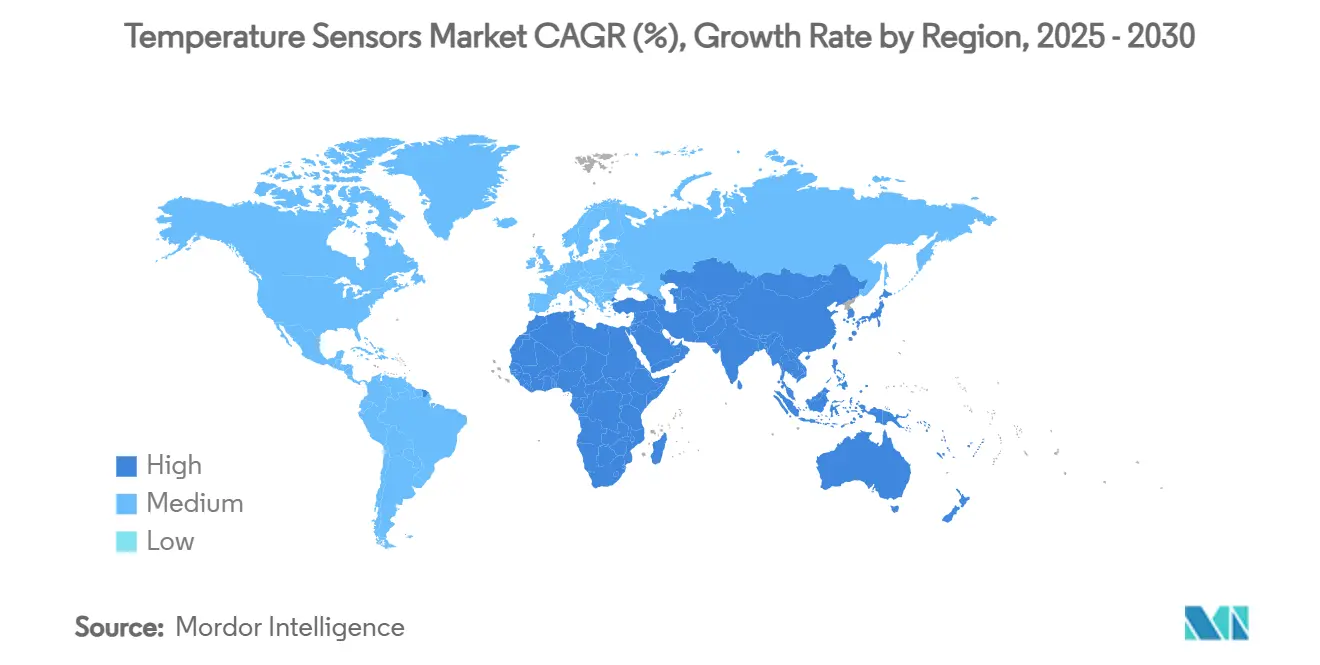
Competitive Landscape
The market is moderately concentrated: the top five groups control roughly 55 % of global revenue, leaving meaningful share for regional specialists. Honeywell, Siemens and Texas Instruments exploit vertical integration, supplying ASICs, packaging, calibration services and cloud dashboards. STMicroelectronics and Infineon target digital IC niches, embedding temperature cores inside PMICs to guarantee board-level thermal protection.
Strategic moves underscore a pivot toward solutions over components. DwyerOmega’s 2024 purchase of Process Sensing Technologies broadened its pharmaceutical and energy analytics suite, while Crane Company’s USD 1.06 billion bet on Baker Hughes’ Precision Sensors bolsters aerospace and nuclear portfolios. SICK and Endress+Hauser formed a process-automation joint venture delivering gas analyzers with integrated temperature outputs, illustrating ecosystem convergence.
Established players guard margins by focusing on medical-grade accuracy, extended-lifetime drift specs and ISO/IEC 17025 calibration certificates. Chinese entrants compete on cost in commodity thermocouples but struggle to meet Western pharma and avionics traceability clauses. Emerging disrupters experiment with quantum-based probes that promise calibration-free operation; NIST’s Rydberg-atom prototype hints at a future niche for ultra-high-precision environments. These dynamics collectively sustain innovation intensity across the temperature sensor market.
Temperature Sensors Industry Leaders
-
Honeywell International Inc.
-
Siemens AG
-
ABB Ltd.
-
Texas Instruments Inc
-
Emerson Electric Co.
- *Disclaimer: Major Players sorted in no particular order
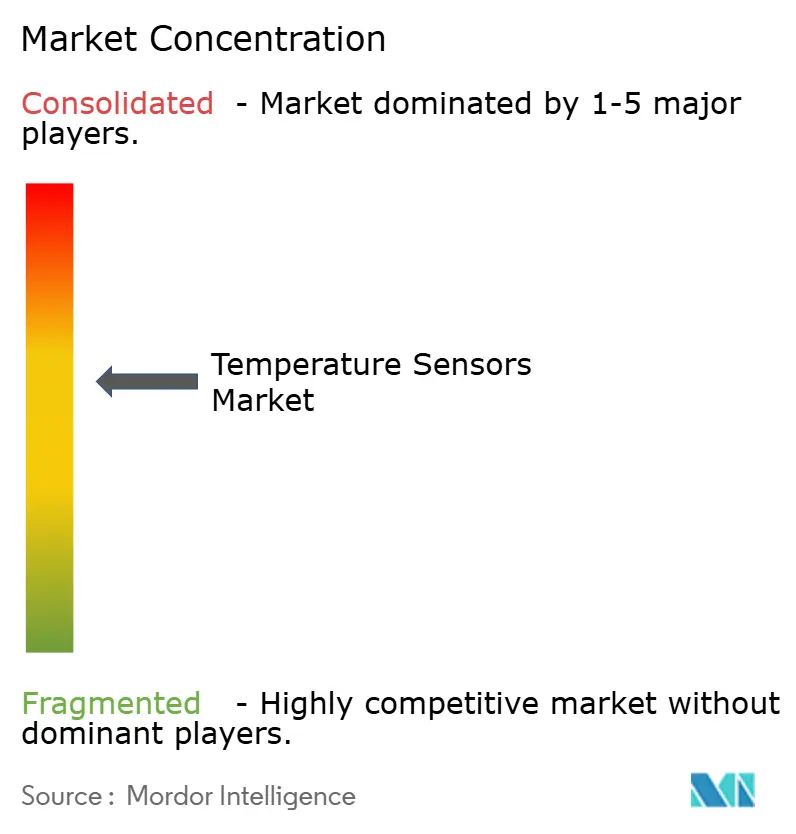
Recent Industry Developments
- February 2025: Sensirion AG launched the STS4L ±0.4 °C low-power temperature sensor targeting IoT wearables.
- February 2025: Honeywell posted 7 % year-over-year sales growth, led by Industrial Automation orders.
- January 2025: Honeywell and NXP partnered to combine neural-network processors with building-automation sensors.
- January 2025: Honeywell and Analog Devices introduced single-pair Ethernet retrofits for commercial-building digitization.
Global Temperature Sensors Market Report Scope
Temperature sensors are devices used to measure temperature readings via electrical signals. The sensor is made of two metals that generate electrical voltage or resistance once it notices a temperature change. The temperature sensors have various sensor types based on the technology type, such as Infrared, Thermocouple, Resistance Temperature Detectors (RTD), thermistors, and others. The report describes the type of sensors, such as wired and wireless, and also provides the study of output, which are analog and digital. The end-user industry comprises temperature sensor applications and majorly includes Chemical and Petrochemical, Oil and Gas, Metal and Mining, Power Generation, Food and Beverage, Automotive, Medical, Aerospace & Military, and others.
The Temperature Sensors market is segmented by Type (Wired, Wireless), Technology (Infrared, Thermocouple, Resistance Temperature Detectors, Thermistor, Temperature Transmitters, Integrated Circuit, Fiber optics), End-user Industry (Chemical and Petrochemical, Oil and Gas, Metal and Mining, Power Generation, Food and Beverage, Automotive, Medical, Consumer Electronics, Aerospace, and Military), and Geography (North America, Europe, Asia-Pacific, Latin America, MEA). The market sizes and forecasts are provided in terms of value (USD million) for all the above segments.
| Wired |
| Wireless |
| Analog |
| Digital |
| Contact Thermocouple |
| Resistance Temperature Detector (RTD) |
| Thermistor (NTC/PTC) |
| Temperature IC |
| Non-Contact Infrared |
| Fiber-Optic |
| Chemical and Petrochemical |
| Oil and Gas |
| Metals and Mining |
| Power Generation |
| Food and Beverage |
| Automotive and E-Mobility |
| Medical and Healthcare |
| Aerospace and Defense |
| Consumer Electronics and Wearables |
| Other Industries |
| North America | United States |
| Canada | |
| Mexico | |
| Europe | United Kingdom |
| Germany | |
| France | |
| Italy | |
| Rest of Europe | |
| Asia-Pacific | China |
| India | |
| Japan | |
| South Korea | |
| Australia | |
| Rest of Asia-Pacific | |
| South America | Brazil |
| Argentina | |
| Rest of South America | |
| Middle East | United Arab Emirates |
| Saudi Arabia | |
| Rest of Middle East | |
| Africa | South Africa |
| Nigeria | |
| Rest of Africa |
| Type | Wired | |
| Wireless | ||
| Output | Analog | |
| Digital | ||
| Technology | Contact Thermocouple | |
| Resistance Temperature Detector (RTD) | ||
| Thermistor (NTC/PTC) | ||
| Temperature IC | ||
| Non-Contact Infrared | ||
| Fiber-Optic | ||
| End-User Industry | Chemical and Petrochemical | |
| Oil and Gas | ||
| Metals and Mining | ||
| Power Generation | ||
| Food and Beverage | ||
| Automotive and E-Mobility | ||
| Medical and Healthcare | ||
| Aerospace and Defense | ||
| Consumer Electronics and Wearables | ||
| Other Industries | ||
| By Geography | North America | United States |
| Canada | ||
| Mexico | ||
| Europe | United Kingdom | |
| Germany | ||
| France | ||
| Italy | ||
| Rest of Europe | ||
| Asia-Pacific | China | |
| India | ||
| Japan | ||
| South Korea | ||
| Australia | ||
| Rest of Asia-Pacific | ||
| South America | Brazil | |
| Argentina | ||
| Rest of South America | ||
| Middle East | United Arab Emirates | |
| Saudi Arabia | ||
| Rest of Middle East | ||
| Africa | South Africa | |
| Nigeria | ||
| Rest of Africa | ||
Key Questions Answered in the Report
What is the current size of the temperature sensor market and how fast is it growing?
The market stands at USD 9.35 billion in 2025 and is forecast to reach USD 12.68 billion by 2030, advancing at a 6.28% CAGR.
Which region leads demand for temperature sensors?
Asia-Pacific holds 44.9% of global revenue and is also the fastest-growing region at a 7.2% CAGR through 2030.
Why are wireless temperature sensors gaining traction?
Brown-field factories and commercial buildings favor wireless nodes because they avoid costly cabling work; this segment is expanding at an 11.8% CAGR.
Which end-user industry shows the highest growth momentum?
Medical and healthcare applications are climbing at an 8.7% CAGR due to strict biologics cold-chain traceability and mRNA vaccine production needs.
Page last updated on:
